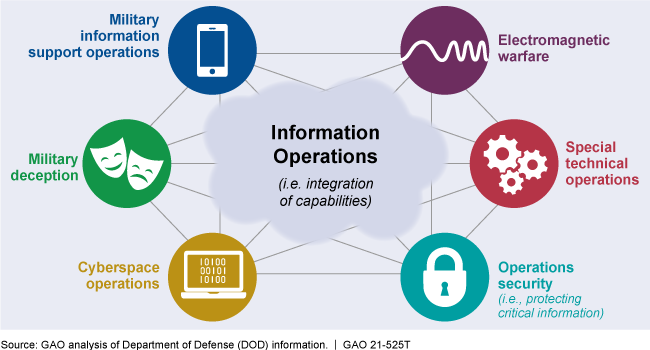Information Environment: DOD Operations Need Enhanced Leadership and Integration of Capabilities
Fast Facts
Potential adversaries (such as Russia and China) are using information to achieve their national objectives and undermine the security and principles of the United States—e.g., propaganda and cyberattacks.
To counter these activities, DOD can use "information operations." These operations integrate DOD activities, such as by combining electromagnetic warfare and cyberspace operations. But we testified that DOD made little progress in implementing its information operations strategy and had challenges conducting information operations.
In our prior work, we recommended that DOD improve its leadership and address its challenges in this area.

Highlights
What GAO Found
At its core, information operations (IO) are the integration of information-related capabilities during military operations to influence, disrupt, corrupt, or usurp the decision making of adversaries and potential adversaries while protecting our own. (See figure.) For example, in seeking to facilitate safe and orderly humanitarian assistance, the Department of Defense (DOD) would conduct IO by influencing host nation and regional cooperation through the integration of public affairs activities and military information support operations.
Information Operations and Selected Information-Related Capabilities

GAO found, in 2019, that DOD had made limited progress in implementing the 2016 DOD IO strategy and faced a number of challenges in overseeing the IO enterprise and integrating its IO capabilities. Specifically:
- In seeking to implement the strategy, DOD had not developed an implementation plan or an investment framework to identify planning priorities to address IO gaps.
- DOD has established department-wide IO roles and responsibilities and assigned most oversight responsibilities to the Under Secretary of Defense for Policy. The Under Secretary had exercised some responsibilities, such as establishing an executive steering group. However, the Under Secretary had not fulfilled other IO oversight responsibilities, such as conducting an assessment of needed tasks, workload, and resources. Instead, the Under Secretary delegated these responsibilities to an official whose primary responsibilities are focused on special operations and combatting terrorism.
- DOD had integrated information-related capabilities in some military operations, but had not conducted a posture review to assess IO challenges. Conducting a comprehensive posture review to fully assess challenges would assist DOD in effectively operating while using information-related capabilities.
Why GAO Did This Study
U.S. potential adversaries—including near-peer competitors Russia and China—are using information to achieve objectives below the threshold of armed conflict. DOD can use information operations to counter these activities.
This testimony summarizes GAO's past work related to DOD's IO capabilities. Specifically, it discusses: (1) DOD's information operation terms and concept, and (2) DOD's actions to implement the 2016 DOD IO strategy and address oversight and integration challenges. This statement is based on GAO's August and October 2019 reports (GAO-19-510C and GAO-20-51SU) and updates conducted in April 2021.
Recommendations
In prior work on which this testimony is based, GAO recommended that DOD take five actions to improve leadership and integration for information operations—including that the department should conduct a posture review to assess integration challenges. DOD disagreed with the recommendations. However, Section 1631 of the National Defense Authorization Act for Fiscal Year 2020 included several provisions related to our recommendations, such as one that required the Secretary of Defense to conduct a posture review.
